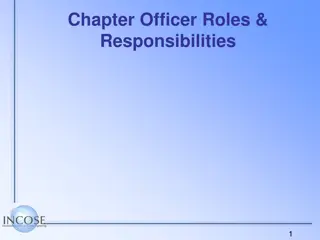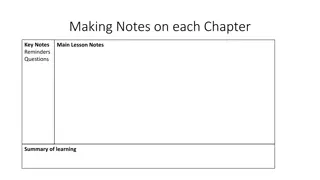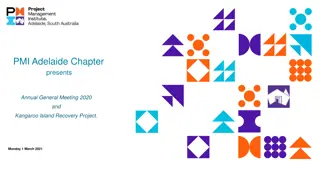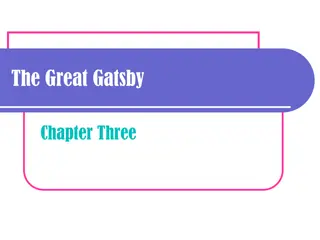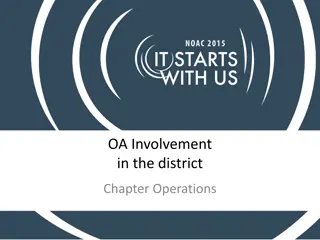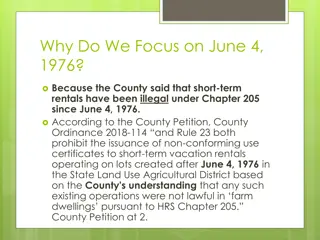
Object Programming Essentials: C++ Concepts and Implementation
Explore the fundamentals of object-oriented programming in C++. Learn how to create classes, objects, inheritance, and data structures while managing memory resources effectively. Enhance your understanding of object interactions and class design for real-world applications.
Download Presentation

Please find below an Image/Link to download the presentation.
The content on the website is provided AS IS for your information and personal use only. It may not be sold, licensed, or shared on other websites without obtaining consent from the author. If you encounter any issues during the download, it is possible that the publisher has removed the file from their server.
You are allowed to download the files provided on this website for personal or commercial use, subject to the condition that they are used lawfully. All files are the property of their respective owners.
The content on the website is provided AS IS for your information and personal use only. It may not be sold, licensed, or shared on other websites without obtaining consent from the author.
E N D
Presentation Transcript
1 CHAPTER 5 (PART 1) Object programming essentials
2 Chapter 5 Objectives After completing this module, the student will be able to: Understand the concept of C++ class and object syntax Create objects Access object members Create setter/getter access methods Limit the range of accepted values in access methods Understand and implement different strategies for obtaining derived data Define a C++ class from scratch Model real-world entities with classes and objects Limit acceptable input range Manage multiple objects Provide meaningful and helpful representation of objects Understand the interactions between objects of the same type
3 Chapter 5 Objectives Create objects based on objects of other objects of custom classes Understand the concept of inheritance syntax and operation Share functionality between objects using inheritance Implement data structures in C++ Understand the concept of dynamic allocation of C++ objects Prevent memory leaks and deallocate acquired resources Provide derived data about the implemented data structure Keep the data structure consistent at all times Traverse data structures Access data stored in data structures Create copies of data structures Implement and use copy constructors
4 5.1 BASIC CONCEPTS OF OBJECT PROGRAMMING
5 5.1.1 Classes and objects in real life All of our programs and all the techniques we ve used up till now fall into the so-called procedural style of programming.
6 5.1.1 Classes and objects in real life Procedural programming works very well for simple projects and not large ones. Large and complex projects carried out by large teams consisting of many developers use Object approach . C++ language was created as a universal tool for object programming.
7 5.1.2 Classes and objects in real life In the procedural approach, we can distinguish two different and separate worlds: data: populated by variables of different types code: inhabited by code grouped into functions. The object approach suggests a completely different way of thinking. The data and the code are enclosed together in the same world, divided into classes
8 5.1.2 Classes and objects in real life Every class is like a recipe that can be used when you want to create a useful object You may produce as many objects as you need to solve your problem. Every object has a set of properties and is able to perform a set of activities (operations, methods).
9 5.1.2 Classes and objects in real life The recipes may be modified if they re inadequate for specific purposes and, in effect, new classes may be created. The new classes inherit properties and methods from the originals and usually add some new ones, creating new and more specific tools. Objects are materializations of ideas expressed in classes much like a piece of cheesecake on your plate is an incarnation of an idea expressed in the recipe printed in an old cookbook.
10 Example: Compute rectangle area. int main() { int L, W; rectangle aobject; cout<<"Enter the length and width of rectangle(L,W)"; cin>>L>>W; aobject.set_len(L); // illegal aobject.length=L; //because, length is private aobject.set_wid(W); // illegal aobject.width=W; //because width is private cout<<"Length:"<<aobject.get_len()<<endl; cout<<"Width:"<<aobject.get_wid()<<endl; cout<<"Area: "<<aobject.area()<<endl; return 0; } class rectangle { private: public: }; int length; int width; void set_len(int a) { length=a; } void set_wid(int a) { width=a; } int get_len() { return length; } int get_wid() { return width; } int area() { return width*length;}
11 5.1.3 Class what is it? Example of Classes (vehicles). All vehicles existing (and not yet existing) in the world are related to each other by a single, important feature: the ability to move. We suggest the following definition for any member of the class vehicles: vehicles are artificially created entities used for transportation, moved by forces of nature and directed (driven) by humans.
12 5.1.3 Class what is it? The vehicles class is very broad. Too broad. We need to define some more specialized classes. The specialized classes are (will be) called sub- classes . The vehicles class will be a super-class for them all. The most general and the widest class is always at the top (a super) while its descendants are below (subs).
13 5.1.3 Class what is it? Sub classes Sub classes Super class
14 5.1.5 Object what is it? Object is an instance of class, which holds the data variables declared in class and the member operations (functions) work on these class objects. You can create as many objects as you want from the same class.
15 5.1.5 Object what is it? For example: any personal car is an object that belongs to the wheeled vehicles class. It also means that the same car belongs to all the superclasses of its home class; therefore, it s a member of the vehicles class, too. Each subclass is more specialized (or more specific) than its superclass. Each superclass is more general (more abstract) than all its subclasses.
16 5.1.7 What does any object have? The object programming convention assumes that every existing object may be equipped with three groups of attributes: A name that uniquely identifies it A set of individual properties ( attributes) A set of abilities to perform specific activities that can change the object itself (operations)
17 5.1.7 What does any object have? There s a hint that can help you identify any of these three spheres. Whenever you describe an object and you use: a noun, you probably define the object s name adjective, you probably define the object s property a verb, you probably define the object s activity
18 5.1.7 What does any object have? Example 1: Max is a large cat who sleeps all day Object name = Max Home class = Cat Property = Size (large) Activity = Sleep (all day) Example 2: A pink Cadillac went quickly Object name = Cadillac Home class = Wheeled vehicles Property = Colour (pink) Activity = Drive (quickly)
19 5.1.8 Why all this? The class you define has nothing to do with object creation The class itself isn t able to create an object you have to create it yourself. It s now time to show you how to define the simplest class and how to create an object. class OurClass{ }; The definition begins with the keyword class. The keyword is followed by an identifier that names the class Next, you add a pair of curly brackets. The content inside these define all the class properties and activities. Our curly brackets are empty, so the class is empty too.
20 5.1.9 The very first object The newly defined class becomes an equivalent of a data type, and we can use it as a type name. Imagine that we want to create one object of the OurClassclass. We declare a variable that can store objects of that class and create an object at the same time. OurClass ourObject;
21 5.1 Practice Lab 5.1.9 (1) Classes and Objects in C++ [A] Lab 5.1.9 (2) Restricting access to object data [A] Lab 5.1.9 (3) Obtaining derived data from an object [B] Lab 5.1.9 (4) Classes and objects: ShopItemOrder [B]
22 5.3 ANATOMY OF THE CLASS
23 5.3.1 Class components A class is an aggregate consisting of variables (also called fields or properties) and functions (sometimes called operations/methods). Both variables and functions are class components /members.
24 5.3.2 Access specifier Three categories of class members private (default) Member cannot be accessed outside the class Public Member is accessible outside the class Protected Used with inheritance (next chapter) Any member (variable or function) can be public, private or protected
25 5.3.2 Access specifiers The following class has three components: one variable of type int called value two functions called setVal and getVal respectively. class is named Class. class Class { int value; void setVal(int value); int getVal(void); }; Since all the components are declared without the use of an access specifier, all three components are private
26 5.3.2 Access specifiers The setVal and getVal components are public they re accessible to all users of the class. The value component is private it s accessible only within the class. class Class { public: void setVal(int value); int getVal(void); private: int value; };
27 5.3.3 Creating an object Any object of the class is equipped with all the components defined in the class. Class the_object(); The public components are available for use. You can do this: the_object.setVal(0); The private components are hidden and unavailable. You mustn t do this: the_object.value = 0; //Syntax Error
28 Example: We can define the function member inside the class We can define the function member outside the class using :: operator x y myObj void fun(); void print();
29 Unified Modeling Language (UML) Class Diagrams This is usually what will be given in the lab. To describe the class graphically. +: member is public -: member is private #: member is protected
C++ Programming: From Problem Analysis to Program Design, Fourth Edition 30 Example These functions cannot modify the member variables of a variable of type clockType const: formal parameter can t modify the value of the actual parameter private members, can t be accessed from outside the class
C++ Programming: From Problem Analysis to Program Design, Fourth Edition 31 Class Functions Getter function: member function that only accesses the value(s) of member variable(s) Setter function: member function that modifies the value(s) of member variable(s) Constant function: Member function that cannot modify member variables Use const in function heading
33 5.3.4 Overriding component names A function that is a class component has full access to other class components, including private ones. If any function introduces an entity of the name identical to any of the class components, the name of the class component is overridden. It can be accessed only by the qualification with the home class name.
34 Example Rubbish value 10
35 5.3.4 Overriding component names The setX function uses a parameter called x. The parameter overrides the class component called x. This means that the assignment x = x; applies to the value parameter and has nothing to do with the component of the same name. One of the proper forms of the assignment looks like this: A::x = x; The qualification unveils the overridden name of the component.
36 5.3.6 Qualifying component names (1) If any class function body is given outside the class body, its name must be qualified with the home class name and the :: operator. A function defined in this way has the same full access to all class components as any function defined inside the class. All rules for overriding names are valid too.
37 5.3.6 Qualifying component names (1) class Class { public: void setVal(int value) { this -> value = value; } int getVal(void); private: int value; }; int Class::getVal(void) { return value; }
38 5.3.7 Qualifying component names (2) Class function names may be overloaded just like ordinary function names. The default parameter values may be used too. All the other restrictions on the construction of the overloaded class functions apply, too.
39 Example class Class { public: void setVal(int value) { this -> value = value; } void setVal(void) { value = -2; } int getVal(void) { return value; } private: int value; }; int main() { Class obj; obj.setVal(20); // call the first version of the function obj.setVal(); // call the second version of the function }
40 5.3.8 Constructors A function with a name identical to its home class name is called a constructor. The constructor is intended to construct the object during its creation i.e. to initialize field values, allocate memory, create other objects, etc. The constructor may access all object components like any other class member function but should not be invoked directly. A constructor has no type
41 Example class Class { public: Class(void) { this -> value = -1; } void setVal(int value) { this -> value = value; } int getVal(void) { return value; } private: int value; };
42 5.3.8 Constructors Declaring the object of the class, e.g. by doing it in the following way: Class object; implicitly invokes the constructor. Note you re not allowed to do either this: object.Class() or this Class::Class();
44 5.3.9 Overloading constructor names (1) Constructors may be overloaded too, depending on specific needs and requirements. The following class has two different constructors that differ in their number of parameters. The actual constructor is chosen during the object s creation. class Class { public: Class(void) { this -> value = -1; } Class(int val) { this -> value = val; } void setVal(int value) { this -> value = value; } int getVal(void) { return value; } private: int value; };
45 5.3.9 Overloading constructor names (1) Look at the following snippet, please: Class object1, object2(100); cout << object1.getVal() << endl; cout << object2.getVal() << endl; The object1 object will be created using a parameter-less constructor, while the object2 will be created with a one- parameter constructor. The snippet will output the following values: -1 100
46 5.3.9 Overloading constructor names (1) Note that you mustn t demand the use of a non- existent constructor this means that the following snippet is wrong: Class objectx(2,100);
48 5.3.10 Overloading constructor names (2) If a class has a constructor (or more precisely, at least one constructor), one of them must be chosen during object creation i.e. you re not allowed to write a declaration which doesn t specify a target constructor. class Class { public: Class(int val) { this -> value = val; } void setVal(int value) { this -> value = value; } int getVal(void) { return value; } private: int value; }; Int main() { Class obj1(5); //legal statement Class obj2; // Syntax Error (no default constructor) }
C++ Programming: From Problem Analysis to Program Design, Fourth Edition 49 Constructors and Default Parameters Using clockType constructor, you can declare clockType objects with zero, one, two, or three arguments as follows: clockType clock1; //Line 2 clockType clock2(5); //Line 3 clockType clock3(12, 30); //Line 4 clockType clock4(7, 34, 18); //Line 5 Note: if you have a constructor with all default parameters you cannot declare a constructor without parameters, they both called default constructor. clockType clockType(int = 0, int = 0, int = 0); clockType clockType (); //illegal in the same class
C++ Programming: From Problem Analysis to Program Design, Fourth Edition 50 5.3.13 Destructors Destructors are functions without any type The name of a destructor is the character '~' followed by class name For example: ~clockType(); A class can have only one destructor The destructor has no parameters The destructor is automatically executed when the class object goes out of scope

